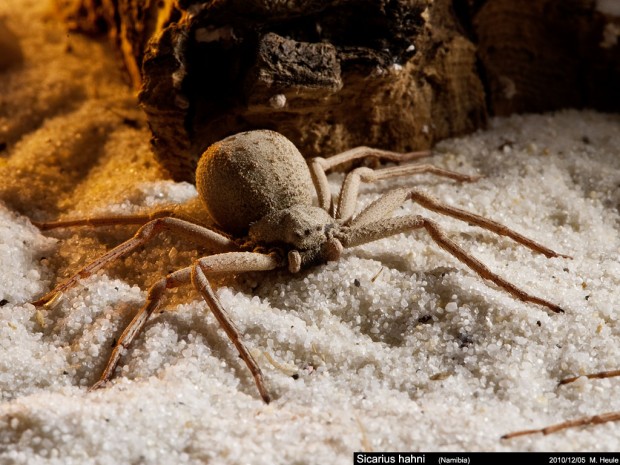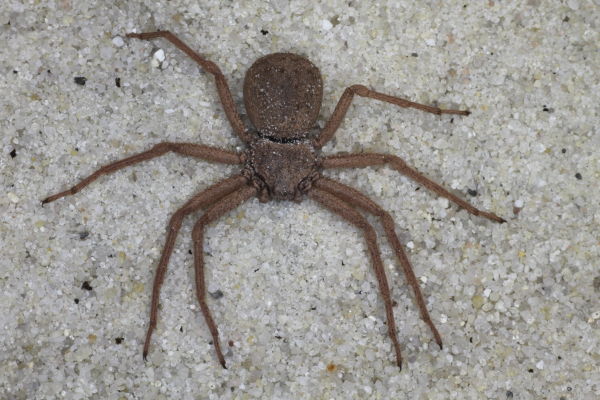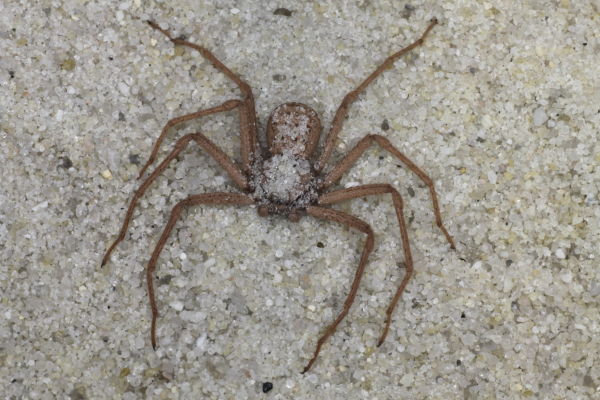Interactions
While glancing over the introduction
to this web page, you probably read the line stating that this spider
is the most
 venomous of any on the planet and went, huh? Why
have I not heard of it before? This spider’s name is seldom
mentioned in the conversation of being the deadliest in the
world because it rarely comes in contact with humans. This is
because of its quiet and sedentary lifestyle consisting of
hiding in sandy places like the South African desert, and the
tendency not to bite when startled. So when looking up deadly
spiders on the internet, Sicarius hahni is sometimes left out, but
this is not because of the potency of its venom. (Here is one
site that ranks it the 5th most dangerous spider in the world
http://www.outdoorlife.com/photos/gallery/survival/2011/10/10-most-dangerous-spiders-world?photo=9#node-1001349303.)
venomous of any on the planet and went, huh? Why
have I not heard of it before? This spider’s name is seldom
mentioned in the conversation of being the deadliest in the
world because it rarely comes in contact with humans. This is
because of its quiet and sedentary lifestyle consisting of
hiding in sandy places like the South African desert, and the
tendency not to bite when startled. So when looking up deadly
spiders on the internet, Sicarius hahni is sometimes left out, but
this is not because of the potency of its venom. (Here is one
site that ranks it the 5th most dangerous spider in the world
http://www.outdoorlife.com/photos/gallery/survival/2011/10/10-most-dangerous-spiders-world?photo=9#node-1001349303.)
Compared to other spider venom that has been researched and analyzed, there is still relatively little known about how the toxin, called a cryotoxin, contained in this spiders venom works. However, it is known that this toxin makes it the deadliest venom of any spider in the world. The reason it is so deadly is because once it enters the body of a prey item, it immediately starts killing cells. This is referred to as a necrotic effect, which means death of tissues and organs. Beginning with skin cells surrounding the bite location, a lesion forms that can reach up to 2.5 cm. Purple bruising also occurs around these lesions that can reach up to 10 cm, as measured in a rabbit. Once the cryotoxin from the venom enters the bloodstream of the victim, the effects begin to be lethal. Hemorrhaging begins to occur, which is the profuse bleeding from ruptured blood cells. Blood cells are then killed, and the toxin can spread to the kidneys and livers, which eventually results in death. In normal prey items, like grasshoppers, these effects happen rather quickly and death can occur within seconds!
Because of these hemorrhaging effects the venom has on organisms, it has been studied for possible use as homeopathic medicine. This type of treatment is based on the idea that a substance that causes sickness in a person will cure a person suffering from that same illness if given in small doses. Envenomation from Sicarius hahni causes similar effects to the Ebola virus, like tissue destruction and hemorrhage. More research needs to be done to confirm this treatment would be effective on humans, however the similarities in the symptoms suggest it could potentially be useful. I don't know about any of you, but I sure would be skeptical about this type of treatment! This spider is one of many animals that can be used for medicinal purposes. Some others are the medicinal leech, a type of sponge, and even a common fly!
To learn more about the adaptations this spider has acquired, click here. Or, back to the home page.

